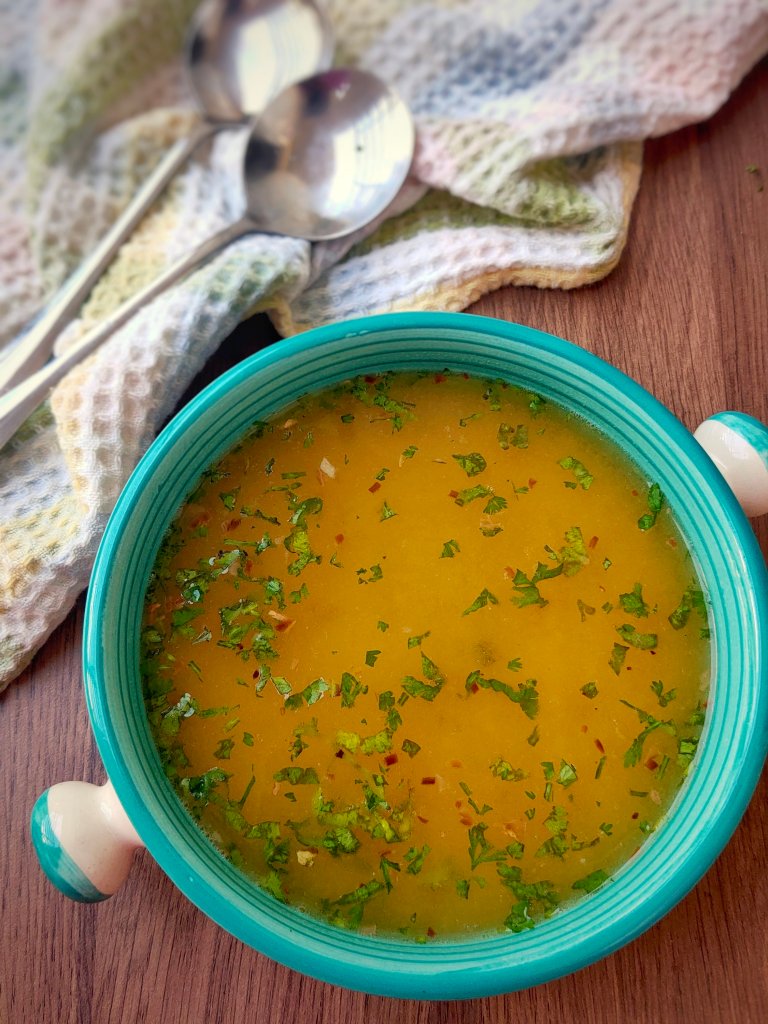If you are looking for a simple but hearty soup that’s hugely satisfying on a winter day, I have just the right thing for you. I’m here today with the recipe for Dal Ka Shorba, an Indian-style soup.

What is Dal Ka Shorba?
Dal Ka Shorba – also called Dal Shorba – refers to a soup made using lentils, spiced the Indian way. It is full of protein, warm and comforting and delicious. I make mine with toor dal and give it a burnt garlic tempering to make it extra special.
I have had the pleasure of tasting Dal Ka Shorba at several North Indian restaurants, and I especially love the one at Moti Mahal. The recipe I have shared here is inspired by these restaurant versions, tried and tested several times over and toned down to just the way my family and I like it.
Why you should try out this Dal Ka Shorba
– It is super easy to make. Once the lentils are cooked, it takes bare minutes to put the soup together.
– This soup needs the bare minimum of ingredients, all easily available in a typical Indian kitchen. There are no fancy or processed ingredients in there – only clean and humble everyday ones.
– Like I was saying earlier, this Dal Ka Shorba is full of protein. It is very nutritious and hearty.
– It is a completely vegetarian and vegan recipe, suited to those following a plant-based diet. It is gluten-free as well.
– This soup manages to be light and appetising in spite of the addition of lentils. It makes for a great addition to a North Indian-style meal.
– It’s delicious! All of us at home absolutely love it, especially the touch of burnt garlic in it. It is so much more than the water left over from cooking lentils.
How to make Dal Ka Shorba
Here is how I make it.
Ingredients (serves 3-4):
- 1/2 cup toor dal
- 1/2 tablespoon oil
- 4-5 cloves of garlic
- A 1-inch piece of ginger
- 3/4 to 1 cup of water
- Salt to taste
- 1/2 teaspoon freshly ground black pepper or to taste
- Juice of 1/2 lemon or to taste
- 1 tablespoon finely chopped fresh coriander or to taste
Method:
1. Wash the toor dal thoroughly under running water. Drain out all the water and place in a wide vessel.
2. Add in enough fresh water to cover the toor dal completely. Place the vessel in a pressure cooker. Pressure cook for 7-8 whistles on high flame or till the dal is well cooked. Let the pressure release naturally.
3. Once the pressure from the cooker has completely gone down, get the cooked toor dal out. Mash it well with a buttermilk churner, to give it a smooth consistency. Keep aside.
4. Peel the ginger and garlic cloves. Chop very finely. Chop the coriander finely. Keep aside.

5. Heat the oil in a pan, and add in the chopped ginger and garlic. Turn the flame down to medium. Cook on medium flame for a minute or till the garlic gets brown. Take care to ensure that it does not burn.
6. At this stage, still keeping the flame at medium, add the cooked and mashed toor dal to the pan. Also add in water, as needed to adjust the consistency of the mixture. I used a little more than 3/4 cup of water.
7. Add in the salt and freshly ground black pepper. Mix well.
8. Cook everything together on medium flame till the mixture comes to a boil. Then, reduce flame even further and simmer the mixture for a minute more. Switch off gas.
9. Mix in lemon juice and chopped coriander. Your Dal Ka Shorba is ready. Ladle into bowls and serve immediately.

#HotPot theme at Shhh Cooking Secretly Challenge
I’m sharing this recipe for Dal Ka Shorba in association with the Shhh Cooking Secretly Challenge.

The Shhh Cooking Secretly Challenge is a group of enthusiastic food bloggers who share recipes based on a pre-determined theme every month. Each month, the group members are divided into pairs, and every pair exchanges two ingredients unknown to the rest of the group. These two ingredients are used by each pair to cook the dish that fits the group’s monthly theme.
It was my turn to suggest a theme for the group this month and, considering it is winter, I chose #HotPot or dishes that are best served piping hot. I was paired with Sasmita of First Timer Cook for the month, and she assigned to me the two secret ingredients of ‘pepper’ and ‘lemon’, and I decided to use them in this beautiful Dal Ka Shorba.
I gave Sasmita ‘curry powder’ and ‘lemon’ as secret ingredients. You guys must definitely check out the wonderful Roasted Cauliflower Soup recipe she has developed using these ingredients!
Tips & Tricks
1. You can use ghee or butter instead of the oil I have used here.
2. The garlic can be omitted, if you don’t prefer to use it.
3. Make sure you chop the ginger and garlic really fine, for best results. You may even julienne the ginger.
4. Make sure the toor dal is well cooked before proceeding to make the soup.
5. Adjust the quantity of lemon juice, salt and pepper as per personal taste preferences. Black pepper powder can be used instead of the freshly ground pepper – that said, I would highly recommend the freshly ground pepper.
6. Adjust the quantity of water depending upon how thick you want the soup to be. I prefer keeping it only slightly thick – not overly so – and not very watery.
7. You can add a dash of roasted cumin (jeera) powder to the soup too. I usually don’t.
Did you like this recipe? Do tell me, in your comments!

















